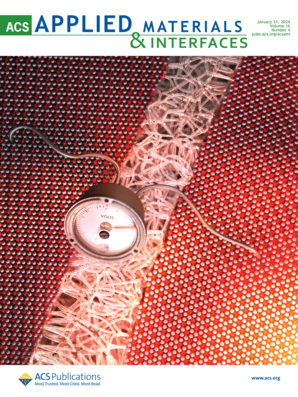硅铁/金系统中与表面等离子体共振相结合的磁光效率
IF 8.2
2区 材料科学
Q1 MATERIALS SCIENCE, MULTIDISCIPLINARY
引用次数: 0
摘要
我们设计和制造的原创层压材料同时表现出不同的特性:磁光性(MO),即横向 MO 克尔效应(T-MOKE)和表面等离子体共振(SPR)。材料设计由电介质层、磁性层和贵金属层组成。我们选择软磁铁硅薄膜作为 T-MOKE 磁层,同时选择金薄膜作为 SPR 源层,从而创造出一种基于铁硅/金的 "MO-SPR 材料"。结果表明,T-MOKE 和 SPR 之间具有很强的相互作用。当波长为 660 纳米的激光束照射该材料时,在 SPR 与材料的夹角 θR 处,T-MOKE 值达到最高。在 θR 处,T-MOKE 明显增强:与 FeSi 单层(参照物)相比,T-MOKE 增加了 ∼32 至 ∼84 倍。MO 活动与电磁场分布之间的强烈相互作用放大了 T-MOKE 的效应。硅铁(5.0 nm)/金(14.8 nm)试样达到了最佳信噪比(SNR)。然后分别使用蒸馏水和葡萄糖溶液测量 T-MOKE 来测试样品的传感效率:可以区分两种不同的溶液。因此,我们利用磁性和近场光的 MO-SPR 材料具有足够的灵敏度,可用作传感材料。此外,由于硅铁 T-MOKE 层具有软磁性,在施加小的外部磁场时,T-MOKE 信号的极性会发生翻转。这对于创建低功耗的高频交流磁同步 T-MOKE 传感系统非常有利。本文章由计算机程序翻译,如有差异,请以英文原文为准。
Magneto-optical efficiencies combined with surface-plasmon resonance in FeSi/Au system
We designed and fabricated our original laminated materials that simultaneously exhibited different properties: magneto-optical (MO), i.e., the transverse MO Kerr effects (T-MOKE) and surface-plasmon resonance (SPR). The material design was composed of dielectric, magnetic, and noble-metal layers. We selected the soft-magnetic FeSi thin film as a T-MOKE magnetic layer, while an Au thin film was chosen as a SPR-source layer, creating an FeSi-/Au-based “MO-SPR material.” Strong interactions between T-MOKE and SPR were demonstrated. When the material is irradiated with a laser beam of wavelength 660 nm, at the SPR angle to the material, θR, the highest T-MOKE value was attained. The T-MOKE was markedly enhanced at θR: ∼32 to ∼84 times higher compared with the FeSi single layer (reference). The T-MOKE was amplified by a strong interaction between MO activities and electromagnetic field distributions. The FeSi (5.0 nm)/Au (14.8 nm) specimen achieved the best signal-to-noise ratio (SNR). The sample was then tested for its sensing efficiency by measuring the T-MOKE using distilled water and a glucose solution, respectively: It was possible to distinguish between two different solutions. Our MO-SPR materials utilizing both magnetism and near-field light are thus sufficiently sensitive to be applicable as sensing materials. Furthermore, the polarity of the T-MOKE signal is flipped under the application of a small, external magnetic field owing to the soft magnetism of the FeSi T-MOKE layer. This is highly advantageous to create high-frequency AC-magnetic synchronized T-MOKE sensing systems with low-power consumption.
求助全文
通过发布文献求助,成功后即可免费获取论文全文。
去求助
来源期刊

ACS Applied Materials & Interfaces
工程技术-材料科学:综合
CiteScore
16.00
自引率
6.30%
发文量
4978
审稿时长
1.8 months
期刊介绍:
ACS Applied Materials & Interfaces is a leading interdisciplinary journal that brings together chemists, engineers, physicists, and biologists to explore the development and utilization of newly-discovered materials and interfacial processes for specific applications. Our journal has experienced remarkable growth since its establishment in 2009, both in terms of the number of articles published and the impact of the research showcased. We are proud to foster a truly global community, with the majority of published articles originating from outside the United States, reflecting the rapid growth of applied research worldwide.
 求助内容:
求助内容: 应助结果提醒方式:
应助结果提醒方式:


